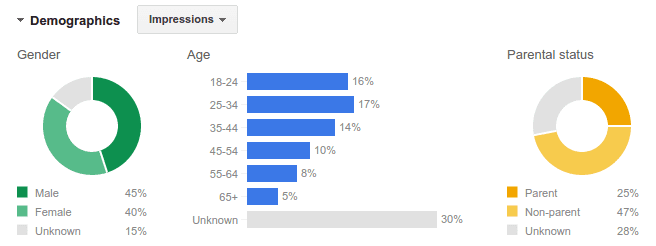Demographic Targeting is one of the most widely under-utilized features in Google AdWords, yet it is an unbelievably powerful asset.
Many advertisers seem unaware of its existence & availability for Search campaigns, despite its inherent ability to increase reach capabilities. Considering most paid search strategies evolve around the idea of finding the right customer at the right time; why not leverage what you know about your customers to help better identify who is right and who isn’t?
There are a few different options for testing demographic bid modifiers for search campaigns as a means of implementing a tailored strategy for each account. For example, a niche retailer probably has a much better idea of who their average customer is compared to a B2B brand, so the strategy for implementing demographic bidding will vary considerably.
Locate Your Demographic Data and Adjust Bids Accordingly
First and foremost, consider the available data for Search campaigns with demographics. While not as expansive as the details advertisers see on the Display Network or even better, Facebook, search campaigns are now able to give performance details related to age tiers and gender.
(Google will identify users logged into Gmail to accumulate this data. To view this data, click into the Audiences tab in AdWords, and then click Demographics.)
 For some industries, most of their users will be identified. For others, the majority of users will remain in the “unknown” category. The B2B industries tend to see this more as users shopping and ordering supplies at that level, as they aren’t logged into personal email accounts.
For some industries, most of their users will be identified. For others, the majority of users will remain in the “unknown” category. The B2B industries tend to see this more as users shopping and ordering supplies at that level, as they aren’t logged into personal email accounts.
It’s important to remember that before making bid adjustments, let the data accrue with a 0% bid modifier. Even if you know that your average customer is a woman in her mid-30s to mid-40s, the online PPC customer demographics might differ. Once you’ve let the data accrue and provide more insights, you can then begin making bid adjustments to funnel spend towards your best performing age groups and genders.
Create Unique Campaigns Based on Target Demographics
After seeing significant data with bid adjustments, consider creating a Target and Bid campaign, only showing ads to select genders. If you’re just layering demographics bids into a campaign, it’s considered “bid only,” meaning you are paying more or less to show to a select demographic, not exclusively showing ads to them.
Target and Bid allows you to only show ads to searchers who meet your demographic criteria. And this is where the strategy can get truly exciting!
By breaking out your top campaign and exclusively showing ads to one demographic, say women of all ages, you can control all of the settings & spend separately from other demographics.
If you know women are much more likely to convert than men, or vice versa, it can be a huge win! Customize your ad copy & landing pages as well as all of the other campaign settings, and the potential for growth becomes significant.
By then, reducing the bids in your mens or womens only campaign can offset costs and keep return strong. In one ROI Revolution account where this strategy was implemented, the first month saw a 42% increase in conversion rate from the prior month, while seeing a drop in cost-per-acquisition by 21%.
Monitor and Adjust Bids Based on Performance
The Target and Bid strategy works well for many retailers, but it also might not be applicable to certain accounts. If most of your data falls into the unknown category, segmenting separate campaigns probably isn’t the winning strategy. In this case, monitoring the bids & ramping up modifiers where performance is strong is best practices.
While it’s tempting to immediately go into a campaign and segment everything by gender & age, avoid getting overzealous. Don’t exclude “unknown” traffic!
The unknown segment could contain considerable volume of prospective customers, but Google hasn’t yet found a way to identify them.
A good tip is to test segmenting on non-branded search campaigns, but don’t segment branded campaigns any more than necessary. CPCs for branded campaigns are low to begin with, and cutting out possible traffic isn’t worth it.
Continue to make adjustments to the keywords & other campaign settings as well. Optimize to make sure you are hitting key performance indicators.
Most importantly, always rely on the data. Don’t assume you know who makes up your customer base. PPC customers might skew differently than your overall average customer base. If you’re not entirely positive about the data AdWords is presenting in the interface, double check with the demographics data in Google Analytics.
Are you interested in learning more about demographic targeting and other AdWords features? Grab our special report, 9 AdWords Traps that Kill Profits. This report gives you a detailed analysis on the major pitfalls that can cripple your ecommerce business. It outlines how you can avoid these obstacles and optimize your AdWords account to increase your overall revenue with a systematic, data-driven approach.


